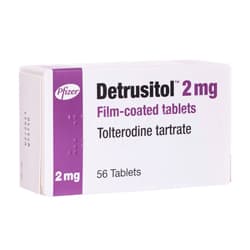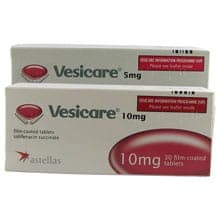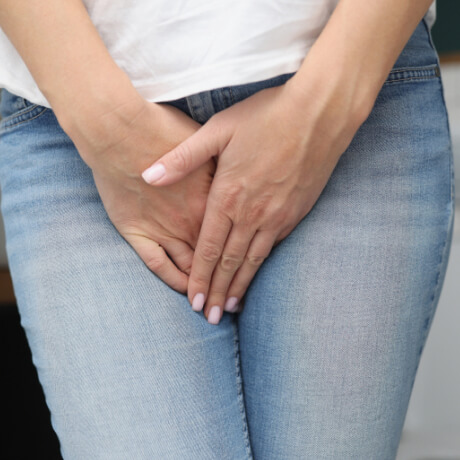Login to your account
- Prescription included
- Genuine medication
- All-inclusive service - No hidden fees
- Free next-day delivery
Incontinence
Get incontinence medication with an online prescription
Incontinence - or urinary incontinence - is defined as the involuntary passing of urine. Incontinence is thought to affect up to 7 million people in the UK, however this number could be even higher as many feel too embarrassed to go to their doctor. While it is more prevalent in women, men can also struggle with incontinence.
Although a common condition, it can be disruptive, causing people to avoid certain activities that put extra strain on their bladder. Thankfully, there are several incontinence treatments available on prescription to help alleviate symptoms and allow you to go about your day worry-free.
Available Treatment(s)

- Effective incontinence treatment
- Helps increase bladder capacity
- Contains active ingredient tolterodine

- Treats urinary incontinence
- Increases bladder capacity
- Reduces leaks and urges
What is incontinence?
Urinary incontinence is the unintentional passing of urine. It is most commonly caused by the pelvic muscles used to prevent urination weakening over time, which is why the condition is most prevalent in older people.
Types of incontinence
There are several types of urinary incontinence that have slightly different symptoms:
- stress incontinence - urine leaks when your bladder is under pressure, such as from laughing, sneezing or exercising
- urge incontinence - urine leaks when you feel a sudden, intense urge to pee, or soon afterwards
- overflow incontinence (chronic urinary retention) - when you’re unable to fully empty your bladder, resulting in frequent leaks
- total incontinence - your bladder cannot store any urine at all, causing you to pass urine or leak constantly
- functional incontinence - when the bladder or bowel is working normally but they are unable to access the toilet, also known as disability associated urinary incontinence
Stress urinary incontinence (SUI) is the most common type, with studies finding as many as 41% of women older than 40 experiencing symptoms of SUI.
What causes incontinence?
Different types of incontinence have various causes. However, incontinence usually involves an issue with the supporting muscles around the bladder: the pelvic floor muscles, the detrusor muscles and the urethral sphincter muscles.

What causes stress incontinence?
Stress incontinence, the most common type, is predominantly caused by the weakening of the pelvic floor and the urethral sphincter muscles.
These muscles support the bladder and can be weakened from childbirth or as you get older. When there’s sudden pressure on the bladder (such as from sneezing or laughing), it becomes greater than the strength being applied by the muscles to keep the urethra (the tube that passes urine out of the body) closed. This causes urine to leak out of the urethra.
What causes urge incontinence?
Urge incontinence is caused by a problem with the smooth muscles surrounding the bladder known as the detrusor muscles.
The function of the detrusor muscles is to relax to allow the bladder to fill with urine, then contract to let the urine out when you go to the bathroom. In those with urge incontinence, these muscles are overactive and contract too often, meaning you experience the urge to pee more often.
This is known as an overactive bladder. It’s not known what causes these muscles to contract too often, but is believed to be linked to constipation, drinking too much alcohol or caffeine, not drinking enough fluids or conditions affecting the lower urethra and bladder (e.g urinary tract infections).
What causes overflow incontinence?
Overflow incontinence is primarily caused by a blockage or obstruction which affects your bladder function. The bladder can be obstructed by bladder stones, constipation and an enlarged prostate gland in men.
While your bladder may fill up as normal, the obstruction will mean it will never empty completely. However, pressure from the urine that’s left in your bladder builds up behind the obstruction, which is what causes leaking.
It can also be caused by a problem with your detrusor muscles where they cannot fully contract, meaning your bladder never empties fully. This can happen in people with nerve damage or who take certain medicines.
What causes total incontinence?
Total incontinence is the most serious type, where the bladder cannot store any urine at all. This is usually caused by a problem with your bladder from birth, a spinal cord injury or a bladder fistula (a small tunnel-like hole that can form between the bladder and a nearby area such as the vagina).
Risk factors for incontinence
Some factors make it more likely for you to develop urinary incontinence and bladder problems, such as:
- being pregnant
- childbirth (especially vaginal births)
- getting older
- menopause
- being overweight
- family history
- bladder surgery or surgery around the area (e.g. prostate surgery)
- certain medicines (e.g HRT, antidepressants and medicines for high blood pressure like diuretics)
- neurological conditions (e.g multiple sclerosis or Parkinson’s disease)
- immobility (due to physical or cognitive disability)
- pelvic organ prolapse
What are the symptoms of incontinence?
The most common sign of urinary incontinence is leaking. This can occur when you laugh, cough, sneeze, exercise or lift a heavy object.
If you have urge incontinence, the defining symptom is feeling a persistent and strong urge to urinate. This urge may also be more easily triggered, such as by hearing running water. You may notice you have to pee more frequently, especially at night (nocturia). Some also pass urine unexpectedly during sex.
It’s not uncommon to experience symptoms of mixed incontinence, which is a combination of both stress and urge incontinence.
Other symptoms include:
- passing small amounts of urine often
- feeling like your bladder is never empty
- feeling as if you need to pee after you have already been
- straining to pass urine
- slow flow of urine
- urine stream stopping and starting
- dribbling after you have finished
However, there are several potential reasons you need to urinate more frequently, so it’s a good idea to get your symptoms checked by a healthcare professional.
How is incontinence diagnosed?
Many may feel embarrassed to go to their doctor about their incontinence, but it’s important you get your symptoms checked.
They’ll start by asking you about your symptoms, and when and how they occur. This will help them diagnose the type of incontinence. Your GP may suggest you keep a bladder diary of your symptoms (e.g. how much you drink, what you drink, how often you have to urinate etc.).
Your doctor may need to do some tests to rule the potential causes of your incontinence, such as:
- a physical examination (of your vagina, rectum or penis)
- a dipstick test - to test your urine for a potential infection
- residual urine test - an ultrasound scan to see how much urine is left in your bladder
- cystoscopy - a small tube with a camera is inserted to look inside your bladder and urinary tract
- urodynamic tests - a group of tests to measure the pressure in your bladder, your stomach as well as measure your urine flow
It’s extremely unlikely that the cause of your symptoms are serious, but you should still get them checked out so you can live your life comfortably.
How can I prevent incontinence?
Some cases of incontinence can’t be prevented, such as childbirth and ageing. However, there are things you can do to lower the risk of developing it.
- lose weight - relieves excess pressure on the bladder
- reducing alcohol and caffeine intake
- altering your fluid intake - as too much or too little can result in incontinence
Pelvic floor exercises
Your pelvic floor muscles are integral for bladder function, and their weakening is the main cause of urinary leakage.
They are layers of muscle stretched like a hammock across the pubic bone to the backbone and can be strengthened by doing pelvic floor muscle exercises, sometimes known as kegel exercises. You can feel your pelvic floor muscles when you squeeze the area around your rectum, and you should feel the sensation of the muscles inward and upward.
There are many different routines you can try, but here’s a simple routine you can try to get started:
- Sit, stand or lie in a comfortable position with your legs slightly apart.
- Tighten and pull up the muscle.
- Start by doing slow exercises - pull up and squeeze the muscle, holding it for up to 10 seconds if you can.
- Relax for 3 - 4 seconds between each squeeze.
- Then, do some quick exercises - pull up and squeeze but release immediately.
- Start by doing 5 slow squeezes and 10 fast squeezes. There’s no set amount of time to do it, but be careful not to overdo it. The maximum you should do is 3 sessions a day.
Strengthening these muscles not only improves bladder control, but it can also help with sex. It can improve orgasms and help with erectile dysfunction in men. In pregnant women, starting pelvic floor muscle exercises can prevent incontinence after you give birth.
Once you’re used to doing them, you can do them at any time without anyone knowing, so they’re easy to add to your daily routine.
How do I treat incontinence?
Incontinence can significantly affect people’s quality of life. However, there are plenty of methods and treatment options for incontinence that can help you feel more confident day-to-day.
Incontinence products
There are several products you can buy that can help control leaking, such as:
- incontinence pads and pull-up pants - absorb any urine to keep the skin dry
- bed and chair pads - washable pads that absorb urine to keep your furniture dry, especially for overnight leaks
- urinals - available as reusable or disposable devices that collect urine
- urinary sheaths - plastic condom-like coverings that drain urine into a drainage bag
It’s important you do not use sanitary pads or tampons to help with incontinence. Whilst they seem like a cheaper alternative to incontinence pads, they don’t use the same absorbent technology and can irritate your skin or, worse, damage your bladder.
Bladder retraining
Bladder training is a behavioural strategy that can help improve your incontinence symptoms over a period of time.The aim is to reduce the amount of times you need to use the bathroom as well as reduce urine leakage and urgency.
It involves using what’s called a fixed voiding schedule. This involves going to the bathroom at specific times during the daytime, times that you and your doctor have decided on. If you feel an urge to pee between scheduled times, use urge suppression techniques such as Kegels and relaxation techniques to help control the urge.
You gradually increase the intervals between scheduled urination times as your urges continue to reduce. If this method is done correctly, you could notice huge improvements within 6 - 12 weeks.
Prescription medicines
If your incontinence doesn’t improve with lifestyle changes or bladder training, you may be suitable for prescription treatment.
The most common group of medicines used to treat incontinence are known as antimuscarinics. These medicines work by relaxing the muscles surrounding your bladder, meaning your bladder can hold more liquid and you do not pee so often. The most common of these medicines include Oxybutynin, Tolterodine (Detrusitol) and Solifenacin (Vesicare).
If you’re not able to take an antimuscarinic (e.g. if you experience uncomfortable side effects), your doctor will prescribe you a drug called Mirabegron instead. It works similarly to antimuscarinics in that it helps the bladder muscles to relax.
Your doctor may also prescribe you Duloxetine, an SNRI (Serotonin-norepinephrine reuptake inhibitor). While most commonly used to treat mood disorders, it can improve the muscles of the urethra to help keep it closed.
Surgery & procedures
In cases where prescription treatment has not helped, then your doctor may consider surgery. There are many different surgeries available for all types of incontinence from sling surgery, bulking agents and catheters to Botox injections and nerve stimulation.
Each procedure comes with its own risks and complications so it’s important you discuss it thoroughly with your doctor. Moreover, not all procedures will be available on the NHS so surgery may be expensive.
Can I buy incontinence treatment online?
You can buy certain prescription medicines for urinary incontinence online here at euroClinix. We offer both Detrusitol and Vesicare tablets. All you have to do is complete a quick medical questionnaire so our doctors can know a bit about your medical history. Once approved for treatment, your prescription will be dispensed and dispatched by our pharmacy with free next-day delivery.
Further reading

What your urine can tell you about your health
Reviewed by Dr. Caroline Fontana
9 reasons you need to pee so often
Reviewed by Dr. Caroline FontanaSelect
medicationFill out a short
medical formDoctor issues
prescriptionMedication sent
from pharmacy
